INFORMATION & RESOURCES FOR OLDER ADULT DRIVERS
View Safety ChecklistIntroduction
This site has been created to educate drivers age 65 and older how to continue to drive safely, despite the barriers that aging may introduce. As you age, your body changes, and some things may make driving more difficult — such as hearing, seeing, and moving. This booklet offers suggestions that will help compensate for these age-related difficulties. Additionally, you will be supplied with information on how to keep and drive a safe car, whether that is taking your car in for a routine service, adding modifications for your individual needs, or going through a comprehensive driving evaluation. The goal is to help you continue to drive safely for as long as possible.
As an older driver, you may have noticed your driving skills aren’t what they were when you proudly received your first driver’s license. And there’s nothing wrong with that. This is an opportunity to learn about ways on how to drive safer, longer. So your life happily rolls along.
A good place to start is to visit your doctor and follow recommendations. Be aware of the side effects of your medications. Get a thorough eye exam. And stay active to maintain your strength and agility.
Your Health
Vision naturally declines over time. It is recommended that you visit your doctor for an eye exam at least once a year, and to always wear your glasses or contacts as your doctor has prescribed. There are three common problems that contribute to poor and declining vision; glaucoma, cataracts, and macular degeneration.
Glaucoma affects peripheral vision which is vital while driving to see all of your surroundings and blind spots. Additionally, glaucoma can cause hazy or blurry vision. Cataracts can occur anywhere in your lens and make things appear cloudy. If left untreated, cataracts will continue to progress and grow, making your ability to see worse.
Macular degeneration occurs as you age, and affects the sharpness of your central vision, or your ability to see directly ahead. Central vision is what you primarily use while driving, because it helps you to judge distances, see small details, and read road signs.
There are set legal vision requirements for driving. The Utah Department of Public Safety and Driver’s License Division requires at least 20/40 vision and peripheral vision of 120 degrees in at least one eye. These requirements may be met either with or without glasses in order to maintain a valid driver’s license. This vision test should be passed once every five years.
Cognition includes memory, judgement, reasoning, quick-thinking and response time. It is important when driving to remember and memorize destinations, locations, routes, traffic laws, and road signs. Judgement and reasoning are important to make safe decisions when driving. Quick-thinking and response time help you to make the safest decision quickly when faced with multiple things at once or something unexpected on the road — such as pedestrians, animals, or another car.
Driving involves multi-tasking, so it is also important to have the ability to switch and divide your attention to different things. If you have recently been diagnosed with Alzheimer’s or dementia, it is important to monitor it in the early stages so you can catch any cognition problems before they cause harm. It is also suggested to make a driving retirement plan with family before it progresses.
According to the National Institute of Health, hearing loss is one of the most common conditions that affects older adults. It is important while driving to be able to hear emergency sirens, car horns, or railroad warnings. Being able to hear these things helps to ensure both your own safety, and the safety of those around you.
It is important to discuss your medications with your doctor before getting behind the wheel — whether they are prescription or over-the-counter medications. There may be possible side-effects and interactions that can impair your driving; such as drowsiness. Knowing the side-effects of your medications will help you to know whether you should be driving or not, and ultimately will keep you and others safe.
Older adults are more likely to be injured or die in a collision. It is important to take the appropriate precautionary measures for safety such as wearing your seatbelt. As you age, your bone density decreases, making you more susceptible to osteoporosis and major fractures — especially in the case of a collision. In order to combat this weakness, it is important to keep up muscle strength and flexibility through regular exercise. Muscle strength makes it easier to make sharp turns or apply the brakes on short notice, while flexibility aids in avoiding injuries by improving your ability to turn your head and body to check your blind spots. Maintaining good range of motion in your upper extremities helps you to operate the steering wheel, navigation system, door, and seat belt.
If you’re experiencing a lack of flexibility or strength, there are exercises that can help. Exercises to strengthen and increase range of motion in the neck, elbow, wrist, shoulder, hands, and fingers will help to improve your driving. Sometimes it may be beneficial to visit an occupational or physical therapist if you feel extra help is needed. Exercise instructions are included in this booklet. If you are not regularly active, be sure to talk to your doctor before engaging in any sort of new physical activity.
If you have stopped driving and have been working towards driving again by seeking help by a professional, you should re-evaluate your physical condition after the course of your treatment is finished. Discuss your progression with your doctor, physical therapist, or occupational therapist to get an opinion on how you are doing and if it is safe for you to start driving again.
Neck, elbow, wrist, shoulder, hand and finger exercises can help increase your strength and flexibility. Strength and flexibility are important while driving because:
- Adequate strength is needed to grip and turn the steering wheel
- Range of motion is needed in the neck to look over your shoulder and to the sides to check for traffic
- Lower extremities need to be strong enough to quickly depress the brake pedal if needed
Always speak with your physician before engaging in physical activity.
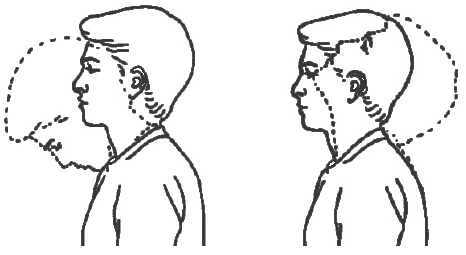
Head Tilts: Tilt your head forward like you are touching your chin to your chest. Then tilt your head back as far as you can without discomfort. Repeat ten times.

Head Tilts (side): Slowly tilt your head to one side, bringing your ear towards your shoulder without shrugging. Then slowly bring it to the other side and repeat ten times.

Head Turns: Turn your head to face to your right, and then slowly bring it back to face to your left. Repeat ten times.
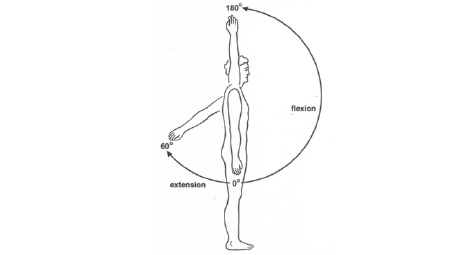
Shoulder Flexion: with your thumb facing up, slowly raise your arm in front of you as far as you can without discomfort or shrugging. Then slowly bring your arm back down to your side. Repeat ten times on each arm.

Elbow Extension/Flexion: Bring your arm straight out to your side, with your palm facing up. Then bend your elbow and touch your shoulder with your fingers. Repeat ten times on each arm.

Wrist Flexion: with your arm resting on a flat surface, bend your wrist so that your fingers are facing up. Then bend your wrist the other way so that your fingers are facing down. Repeat ten times on each wrist.
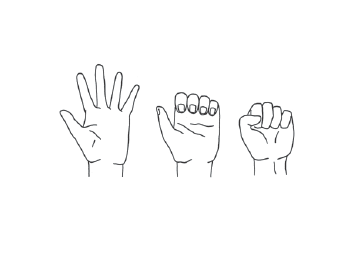
Hand/Finger Spreads: With an open palm, spread your fingers apart as far as you can without discomfort. Then bring them in, and make a half-fist, with your fingers bending at the second knuckle down, and then make a complete fist. Reverse this motion and repeat ten times on each hand.
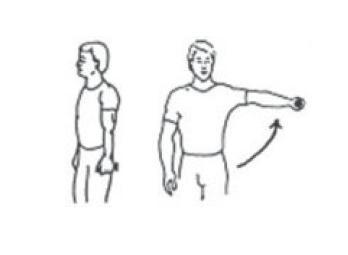
Shoulder Abduction: With your thumb up, slowly bring your arm out to your side as high as you can without discomfort and then slowly bring it back down. Repeat ten times on each arm.
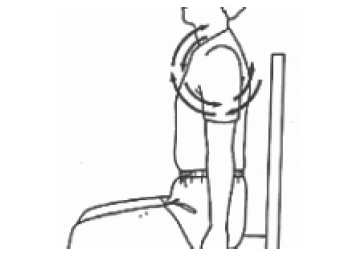
Shoulder Rolls: With your arm down to your side, roll your shoulders back in a circular motion ten times. Then reverse and roll your shoulders forward in a circular motion ten times.
Your Car
CarFit is a nationwide educational program sponsored by AAA, AARP, and the American Occupational Therapy Association. It enhances the safety of older drivers by making sure vehicles are adjusted to ‘fit’ you at events or teaches you how to adjust the ‘fit’ of your vehicle on your own. Carfit keeps you and others safe. You can find event times and locations on their website.
Carfit is all about the safest car for you. It’s important to always test drive a new car thoroughly to make sure that it’s comfortable for you. A thorough test drive should include time on the highway and time on city streets. There are five things you can do to ensure a comfortable and safe car:
- Adjust or add mirrors for improved visibility.
- Make sure the car is easy to get in and out of, and that reaching the seat belt buckle is easy. Adjust the seat or add a seat belt extender if needed.
- Make sure the steering wheel is adjustable and that you are able to see at least three inches above it.
- Get comfortable with the use of gas, brakes, and navigation system. Can you reach the gas and brake pedals, or do you need extenders?
- Make sure your car has safety features such as additional airbags, alert systems, and good crash reviews.
- For more information, visit their website at https://www.car-fit.org/
There are four basic area recommendations for maintaining your car. First, always be sure to keep your car up to date on Safety and Emissions. The state of Utah mandates that your car be inspected by professionals once a year to ensure that the engine is not emitting any pollutants. If your vehicle is less than six years old, it is only required to have the emission test once every two years. It is also suggested that you consider the condition of your windshield, tires, and brakes.
To improve visibility, replace your car’s wiper blades when they wear out or break. A good way to know when they are worn out is when they begin to screech and create streaks. This means they are not making the appropriate contact with the windshield, and not doing their job. Do not add additional tinting to your car windows, as this may decrease visibility.
For tire maintenance, check your car’s owner’s manual or the inside of your driver’s door for the appropriate inflation and tread levels. A tire pressure gauge will easily tell you the inflation level. Make sure all four tires are at the same level so that they wear evenly.
Have your brakes checked by a mechanic every 6,000 miles, or immediately if you hear any sort of grinding or screeching. If the brake pedal loses firmness, or the steering wheel begins to vibrate when you apply the brakes, that is a sign that you should have your brakes checked.
Certain modifications and features may be added to your vehicle to compensate for a disability or age-related changes. It may also be a good idea to make changes to your driving habits in order to continue driving safely. For any physical modifications to your car, you may want to meet with an Occupational Therapist to discuss the best option, along with using possible resources such as the National Mobility Equipment Dealers Association-Quality Assurance Program (NMEDA-QAP) dealer to obtain the appropriate equipment.
There are several ways to modify your driving habits in order to drive in the best conditions for you. If you are beginning to experience changes related to age, you may want to avoid driving at night or in bad weather to increase your visibility and avoid treacherous terrain. Another thing to consider avoiding is making left turns — they require a lot of focus and keeping track of multiple things at once. Ways that you can combat these modifications is by driving in well-lit areas and on familiar roads.
Adaptive equipment can help compensate for age-related changes. There are modifications that can be made to assist in getting in and out of your vehicle, storing a wheelchair, increasing your ability to see to either side and behind your vehicle, turning the steering wheel, and maintaining a seated position with vision at least three inches above steering wheel.
For example, seat cushions can help give you better visibility above the steering wheel as well as ensuring that your seat belt is in the proper place. Pedal extenders make it easier and more comfortable to reach the gas and the brake pedals, and spinner knobs can be attached to the steering wheel to assist in steering. If you are experiencing difficulty reaching your seatbelt across yourself to buckle, you can get a seat belt adapter to that extends your reach.
There are many other modifications that can be made to your car, and an occupational therapist can help you determine the best ones.
University of Utah Health has partnered with the Utah Department of Public Safety to create the Yellow Dot Program. This program provides emergency personnel with vital medical information about you and your family members in the unfortunate case of a collision.
Participants are given a Yellow Dot information form, medical history form, and a round yellow sticker, all enclosed in a red envelope. The information provided by the Yellow Dot form helps emergency responders give you the best treatment if you are unable to communicate with them.
Place the Yellow Dot sticker on the inside of the driver’s side of the windshield near the oil-change reminder stickers. The sticker will withstand a shattered windshield, and it’s where emergency personnel are trained to look. Put the medical information form in the glovebox where emergency personnel can access it in the case of a collision. The form includes spaces for a picture, your name, language, emergency contacts, preferred hospitals, insurance information, primary care physician, and basic medical history such as medications, medical conditions, and allergies.
For more information, call 801-585-2991, email jamie.troyer@hsc.utah.edu or visit utahyellowdot.com
Your Brain
Maintaining “brain fitness” can help you improve your driving. Brain fitness sharpens your processing speed, decision making, and reaction time through cognitive training. Training may include computer-based exercises created specifically for sharpening the mind, Sudokus, and crossword puzzles.
It is extremely important to always make safe choices while driving. Always wear your seatbelt and make sure that all of your passengers do as well. Do not drive distracted. Put your phone on silent and away where it will not bother you. Do not fidget with the radio controls too much, and avoid eating or applying makeup when you are driving.
Never, ever drive under the influence. This not only includes alcohol and recreational drugs, but also over-the-counter or prescription medications that can cause dangerous side effects. Keep in mind that alcohol may cause negative side effects when combined with medications. It is important to be educated about the effects of your medications and what they do not mix well with.
Do not drive drowsy, even if you think you can make it. Driving drowsy has the same effect as driving intoxicated. And remember, older adults need just as much sleep as young people. If you are struggling with your sleep, talk with your doctor.
A Comprehensive Driving Evaluation is an objective process performed by a trained Occupational Therapist (OT) with a specific, specialized skill-set in driving rehabilitation. It is used to determine if you have the expertise to continue to stay safe on the road. The entire evaluation process takes about two to three hours, includes tips on how to improve your driving, and also possible training resources.
How it works:
Clinical Assessment: This step includes an assessment of cognitive, visual, physical, and motor function abilities.
On-Road Test: The on-road tests are either completed on a simulator, or in a vehicle that has been equipped with the necessary controls such as an emergency brake on the passenger side and a variety of vehicle modifications to fit your needs. If the on-road test is not offered, be sure to ask your OT why.
Discussion: During the discussion portion, the OT will give you feedback on your strengths and weaknesses. Typically, you will then review your goals and make a plan with limitations or modifications to your vehicle or driving habits. Some modifications may include avoiding driving in certain circumstances and/or adding modifications such as extra mirrors to your car. The OT may suggest whether it is time for you to stop driving or not. If it is time to stop, the OT should help you transition to a passenger by making you aware of the resources in your area that will help you to continue to stay mobile and independent in your community via alternative transportation.
In a word — EVERYBODY!
- If you feel driving continues to be fine
- If you are “feeling” your age
- If you have one or more medical conditions
- If you have vision loss or changes (specifically peripheral vision loss)
- If you have been told to stop driving-but you don’t agree
- If you want to start driving again after a break
- If your circumstances change how often or where you drive
- If you were recently diagnosed with Alzheimer’s or dementia
- If your doctor recommends it post-stroke, traumatic brain injury, spinal injury, or other neurological condition.
Your OT will work with you to make a plan to continue driving safe, aid in the transition from driver to passenger, recommend modifications (to driving habits or vehicle), additional training, and interpret test results.
If it’s time for you to stop driving, your OT will explain the reasons why, so that you can make the decision to keep yourself and others safe.
To learn more, contact the Driving Rehabilitation Program at U of U Health Sugar House Outpatient Rehab Clinic visit the Rehabilitation Center page.
Self-Assessment Tools can help you to objectively see where you are at as a driver. They are typically a short survey, and once finished, you are given a score. AAA offers self-evaluation online at seniordriving.aaa.com. To get to the tool, click on “Evaluate Your Driving,” and then click on “Self-Rating Tool”. From here you can begin your assessment.
We also suggest you complete a self-reflection on your experience as a driver.
Ask yourself questions such as:
- What are your strengths as a driver?
- What are your weaknesses as a driver?
- Is there anyone that would be able to drive you if you felt uncomfortable driving yourself?
If you feel fairly confident in your driving ability, you may want to consider enrolling in a Defensive Driving course. Defensive Driving courses act as a refresher course on how to improve your driving by giving you tips and tricks to stay safe. By doing so, you can reduce your chance of being in a collision and sustaining critical injuries or worse.
Defensive Driving courses cover state laws, basic driving techniques, and also age-related changes, such as how medication can affect driving. A few resources for defensive driving classes include the AARP Driver Safety Program, AAA Mature Driver Class, and the National Safety Council’s Defensive Driving Course (found at https://www.nsc.org/safety-training/defensive-driving/courses/online).
The Passenger
If you are beginning to notice the effects of aging, do not ignore the warning signs. Signs can include vision and hearing loss, loss of strength, flexibility, agility, overall fitness, cognitive depreciations such as loss of memory, poor judgement and decreased reaction time. It is also important to be aware of the possible side effects and interactions of your medications, and to avoid driving if they cause drowsiness or other potentially dangerous effects.
Before the time comes to discontinue driving, make a driving retirement plan with your family so that you know what to do when the time comes. As you begin the transition from driver to passenger, try to limit your driving and reduce your need to drive. Use alternative transportation such as carpooling or public transit. Invite family members and friends to visit you at your home, rather than you traveling to them.
You can also consider medication and delivery services.
The physiology of dementia is unpredictable and affects different regions of the brain that are supposed to work together. This oftentimes results in the impairment of one or more of the functions that are needed to drive. Because of the unpredictability of Alzheimer’s and dementia, it is smart to begin discussing your plan for driving retirement in the early stages. This helps to smooth the transition from driver to passenger, and it also keeps you involved.
Talk to your doctor about having a Comprehensive Driving Evaluation while you are still in the early stages and have your driving re-evaluated as is recommended by a professional. Gradually modify your driving habits to ease into the role of passenger. Ways to modify your driving include, but are not limited to: driving shorter distances, staying on familiar roads, avoiding difficult interchanges, heavy traffic, bad weather, or driving at night.
Just because it may be time for you to stop driving, doesn’t mean you can no longer be independent.
There are various forms of alternative transportation that you can access. Your family and friends are a great resource to find a ride. Pick someone you are comfortable with, and you know would be willing to drive you places. Caregivers may also be an option for alternative transportation. Look into riding public transit, such as the city bus or train. Some public transit companies may even offer discounts for seniors. Uber and Lyft-type agencies are also an option. To get a ride with them, you call or message for a driver to take you where you need to go. It is similar to taxi services, but without having to hail them off the street. If you would be more comfortable with something more individualized and professional, you could always go through a private transportation system. These agencies may have accommodations for your personal needs and possible disabilities.
Driving Retirement
When beginning the discussion about driving retirement with a loved one, it is important to create a comfortable, caring conversation. Thoughtfully pick who should be the one to initiate the conversation. Choose this person based on personality, experience, and their relationship with the loved one in question. Generally, spouses would prefer to hear from their spouses, but doctors’ opinions are well-valued outside of the family. Adult children have a greater influence on parents that are 70 or older, as compared with those in their 50s and 60s. Other options for conversation starters might be a close friend, or other family member, such as an in-law or sibling.
Consider when it would be the best time to talk. Start by having small conversations before unsafe driving becomes an issue. By having short, frequent conversations rather than one big one after driving has become a problem, you can avoid overwhelming your loved one with everything at once. Additionally, you should make sure that the conversation takes place in a comfortable, and safe environment. Start talking with your loved one when you begin to notice warning signs, such as effects and amount of medications, cognitive status, or change in vehicle ownership.
Think about what you want the conversation to accomplish. Is your goal to get them to the point where they accept help from family and friends? Or do you plan to help them set up a plan for alternative transportation? Encourage them to talk to their doctor about completing a Comprehensive Driving Evaluation. A Comprehensive Driving Evaluation will give them an objective opinion from a professional about their driving.
- Get the facts and look for warning signs.
- Observe the driver over time.
- Discuss your concerns with a doctor.
- Investigate alternatives.
- Be supportive.
The physiology of dementia is unpredictable and affects different regions of the brain that are supposed to work together. This oftentimes results in the impairment of one or more of the functions that are needed to drive. Because of the unpredictability of Alzheimer’s and dementia, it is smart to begin discussing your plan for driving retirement in the early stages. This helps to smooth the transition from driver to passenger, and it also keeps you involved.
Talk to your doctor about having a Comprehensive Driving Evaluation while you are still in the early stages and have your driving re-evaluated as is recommended by a professional. Gradually modify your driving habits to ease into the role of passenger. Ways to modify your driving include, but are not limited to: driving shorter distances, staying on familiar roads, avoiding difficult interchanges, heavy traffic, bad weather, or driving at night.
Just because it may be time for you to stop driving, doesn’t mean you can no longer be independent.
There are various forms of alternative transportation that you can access. Your family and friends are a great resource to find a ride. Pick someone you are comfortable with, and you know would be willing to drive you places. Caregivers may also be an option for alternative transportation. Look into riding public transit, such as the city bus or train. Some public transit companies may even offer discounts for seniors. Uber and Lyft-type agencies are also an option. To get a ride with them, you call or message for a driver to take you where you need to go. It is similar to taxi services, but without having to hail them off the street. If you would be more comfortable with something more individualized and professional, you could always go through a private transportation system. These agencies may have accommodations for your personal needs and possible disabilities.
If your loved one refuses to stop driving, and they are a potential danger behind the wheel, speak with their doctor. Their doctor may be able to convince them to retire from driving in order to keep themselves and others safe. If this does not work, try having others talk to them such as a spouse, adult children, other supports, or a police officer. As a last resort, you may need to disable the car or take away their keys. Again, this is a last resort.
